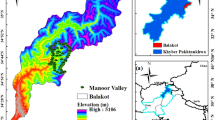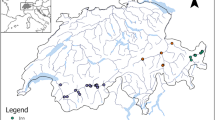Abstract
direct gradient analysis was applied to the montane vegetation of the Mt. Field massif, Tasmania. Ecological response surface were constructed, describing the relationship between the mean % cover of each of 100 vascular plant species and two major environmental complex-gradients represented by soil drainage and altitude. The hypotheses tested were that: (1) the ecological responses of species are generally of Gaussian form; (2) the modes of ‘minor’ species have a uniform random distribution along gradients; (3) the modes of ‘major’ species are evenly distributed; (4) the frequency distribution over species of modal abundance is either lograndom or lognormal; and (5) alpha diversity has a unimodal trend along environmental gradients. The hypotheses were tested both for the full site of vascular species and for each of five species groups defined by structural form. Hypothesis (1) was rejected: only 45% of species had response surface which appeared unimodal and symmetric. Hypotheses (2) and (4) were rejected for the full set of species, but each was supported for all but one of the structural groups. The modes of herb species were clumped, rather than random and the frequency distribution of modal percentage cover for shrubs was inconsistent with both lograndom and lognormal hypotheses. Contrary to hypothesis (3), the modes of ‘major’ species were randomly distributed. Although total alpha diversity had a complex trend surface, the patterns for the alpha diversities of each structural group were unimodal, in accordance with hypothesis (5). The results suggest that an adequate model of community variation along environmental gradients must take into account differences in response patterns between species groups.
Similar content being viewed by others
References
AustinM. P. 1976. On non-linear species response models in ordination. Vegetatio 33: 33–41.
AustinM. P. 1980. Searching for a model for use in vegetation analysis. Vegetatio 42: 11–21.
AustinM. P. 1985. continuum concept, ordination methods and niche theory. Ann. Rev. Ecol. Syst. 16: 39–61.
AustinM. P. 1987. Models for analysis of species' response to environmental gradients. Vegetatio 69: 35–45.
AustinM. P. & AustinB. O. 1980. Behaviour of experimental plant communities along a nutrient gradient. J. Ecol. 68: 891–918.
AustinM. P. & CunninghamR. B. 1981. Observational analysis of environmental gradients. Proc. Ecol. Soc. Aust. 11: 109–119.
AustinM. P., CunninghamR. B. & FlemingP. M. 1984. New approaches to direct gradient analysis using environmental scalars and statistical curve-fitting procedures. Vegetatio 55: 11–27.
AustinM. P., GrovesR. H., FrescoL. F. M. & KayeP. E. 1985. Relative growth of six thistle species along a nutrient gradient with multispecies competition. J. Ecol. 73: 667–684.
BrownJ. H. 1984. On the relationship between abundance and distribution of species. Am. Nat. 124: 255–279.
DaubenmireR. 1966. Vegetation: identification of typal communities. Science 151: 291–298.
Dimmock, G. M. 1961. Reconnaissance soil map of Tasmania: sheet 74 Ellendale. CSIRO Division of Soils, divisional report 5/61.
EllenbergH. 1954. Über einige Fortschritte der kausalen Vegetationskunde. Vegetatio 5/6: 199–211.
FaithD. P., MinchinP. R. & BelbinL. 1987. Compositional dissimilarity as a robust measure of ecological distance. Vegetatio 69: 57–68.
GauchH. G. 1982. Multivariate analysis in community ecology. Cambridge University Press, Cambridge.
GauchH. G. & WhittakerR. H. 1972. Coenocline simulation. Ecology 53: 446–451.
GauchH. G. & WhittakerR. H. 1976. Simulation of community patterns. Vegetatio 33: 13–16.
GleasonH. A. 1939. The individualistic concept of the plant association. Am. Midl. Nat. 21: 92–110.
GoodallD. W. 1963. The continuum and the individualistic association. Vegetatio 11: 297–316.
Greig-SmithP. 1980. The development of numerical classification and ordination. Vegetatio 42: 1–9.
GrimeJ. P. 1973. Control of species density in herbaceous vegetation. J. Environ. Manage. 1: 151–167.
HillM. O. & GauchH. G. 1980. Detrended correspondence analysis, an improved ordination technique. Vegetatio 42: 47–58.
Jones. R. 1969. Fire-stick farming. Aust. Nat. Hist. September 1969: 224–228.
KeddyP. A. 1983. Shoreline vegetation in Axe Lake, Ontario: effects of exposure on zonation patterns. Ecology 64: 331–344.
McIntoshR. P. 1967. The continuum concept of vegetation. Bot. Rev. 33: 130–187.
Minchin, P. R. 1983. A comparative evaluation of techniques for ecological ordination using simulated vegetation data and an integrated ordination-classification analysis of the alpine and subalpine plant communities of the Mt. Field plateau, Tasmania, Ph.D. thesis, University of Tasmania.
MinchinP. R. 1987a. An evaluation of the relative robustness of techniques for ecological ordination. Vegetatio 69: 89–107.
MinchinP. R. 1987b. Simulation of multidimensional community patterns: towards a comprehensive model. Vegetatio 71: 145–156.
OgdenJ. & PowellJ. A. 1979. A quantitative description of the forest vegetation on an altitudinal gradient in the Mount Field National Park, Tasmania, and a discussion of its history and dynamics. Aust. J. Ecol. 4: 293–325.
PeetR. K. 1978. Forest vegetation of the Colorado Front Range: patterns of species diversity. Vegetatio 37: 65–78.
PielouE. C. 1977. Mathematical ecology. John Wiley & Sons, New York.
SampsonR. J. 1978. Surface II graphics system (revision 1). Kansas Geological Survey, Lawrence, Kansas.
ShipleyB. & KeddyP. A. 1987. The individualistic and community-unit concepts as falsifiable hypotheses. Vegetatio 69: 47–55.
SokalR. R. & RohlfF. J. 1969. Biometry: the principles and practice of statistics in biological research. Freeman, San Francisco.
ter BraakC. J. F. 1985. Correspondence analysis of incidence and abundance data: properties in terms of a unimodal response model. Biometrics 41: 859–873.
UnderwoodA. J. 1978. The detection of non-random patterns of distribution of species along a gradient. Oecologia 36: 317–326.
WergerM. J. A., LouppenJ. M. W. & EppinkJ. H. M. 1983. Species performance and vegetation boundaries along an environmental gradient. Vegetatio 52: 141–150.
WestmanW. E. 1980. Gaussian analysis: identifying environmental factors influencing bell-shaped species distributions. Ecology 61: 733–739.
WhittakerR. H. 1951. A criticism of the plant association and climatic climax concepts. Northwest Sci. 25: 17–31.
WhittakerR. H. 1956. Vegetation of the Great Smoky Mountains. Ecol. Monogr. 26: 1–80.
WhittakerR. H. 1960. Vegetation of the Siskiyou Mountains, Oregon and California. Ecol. Monogr. 30: 279–338.
WhittakerR. H. 1967. Gradient analysis of vegetation. Biol. Rev. 42: 207–264.
WhittakerR. H. 1975. Communities and ecosystems. 2nd ed. MacMillan, New York.
WhittakerR. H. & GauchH. G. 1978. Evaluation of ordination techniques. In: WhittakerR. H. (ed.), Ordination of plant communities, pp. 227–336. Junk, The Hague.
WilsonM. V. & MohlerC. L. 1983. Measuring compositional change along gradients. Vegetatio 54: 129–141.
ØklandR. H. 1986a. Rescaling of ecological gradients. I. Calculation of ecological distance between vegetation stands by means of their floristic composition. Nord. J. Bot. 6: 651–660.
ØklandR. H. 1986b. Rescaling of ecological gradients. II. The effect of scale on symmetry of species response curves. Nord. J. Bot. 6: 661–669.
Author information
Authors and Affiliations
Rights and permissions
About this article
Cite this article
Minchin, P.R. Montane vegetation of the Mt. Field massif, Tasmania: a test of some hypotheses about properties of community patterns. Vegetatio 83, 97–110 (1989). https://doi.org/10.1007/BF00031683
Accepted:
Issue Date:
DOI: https://doi.org/10.1007/BF00031683




